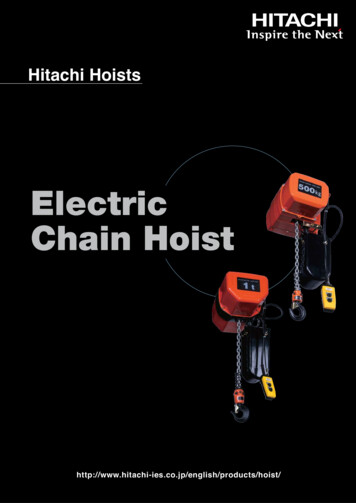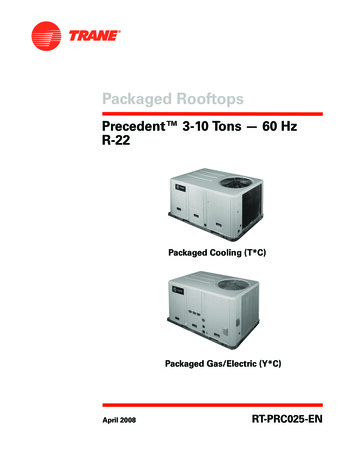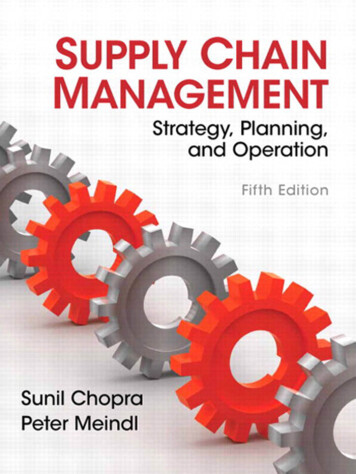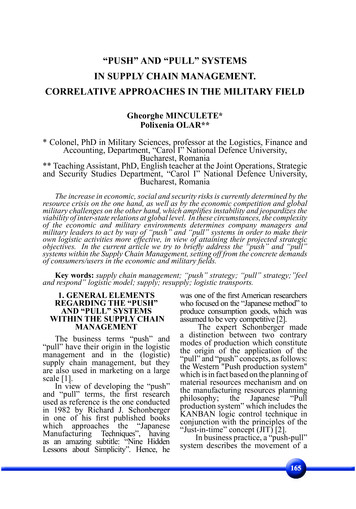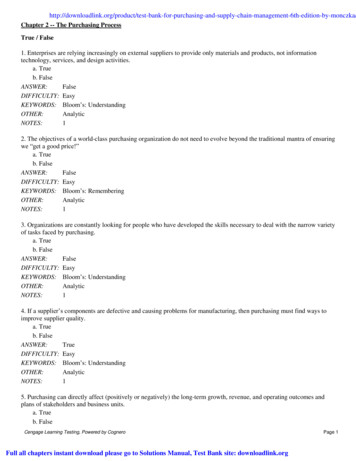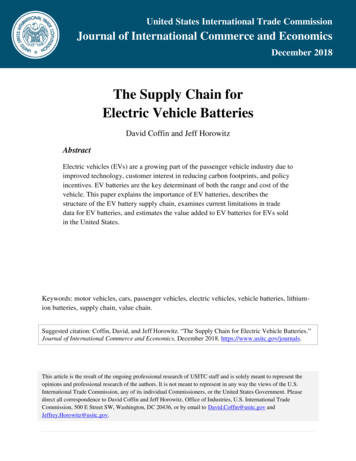
Transcription
United States International Trade CommissionJournal of International Commerce and EconomicsDecember 2018The Supply Chain forElectric Vehicle BatteriesDavid Coffin and Jeff HorowitzAbstractElectric vehicles (EVs) are a growing part of the passenger vehicle industry due toimproved technology, customer interest in reducing carbon footprints, and policyincentives. EV batteries are the key determinant of both the range and cost of thevehicle. This paper explains the importance of EV batteries, describes thestructure of the EV battery supply chain, examines current limitations in tradedata for EV batteries, and estimates the value added to EV batteries for EVs soldin the United States.Keywords: motor vehicles, cars, passenger vehicles, electric vehicles, vehicle batteries, lithiumion batteries, supply chain, value chain.Suggested citation: Coffin, David, and Jeff Horowitz. “The Supply Chain for Electric Vehicle Batteries.”Journal of International Commerce and Economics, December 2018. https://www.usitc.gov/journals.This article is the result of the ongoing professional research of USITC staff and is solely meant to represent theopinions and professional research of the authors. It is not meant to represent in any way the views of the U.S.International Trade Commission, any of its individual Commissioners, or the United States Government. Pleasedirect all correspondence to David Coffin and Jeff Horowitz, Office of Industries, U.S. International TradeCommission, 500 E Street SW, Washington, DC 20436, or by email to David.Coffin@usitc.gov andJeffrey.Horowitz@usitc.gov.
The Supply Chain for Electric Vehicle BatteriesIntroductionSupply chains spreading across countries have added complexity to tracking international tradeflows and calculating the value each country receives from a particular good. This articleexplores the supply chain of one such good, the lithium-ion battery powering an electricpassenger vehicle.1Electric vehicles (EVs) are becoming an increasingly important part of the automotive landscape.According to a 2018 Morning Consult survey, only 23 percent of adults believe gasoline willpower a majority of motor vehicles in the year 2050, while 44 percent believe the majority willbe powered by electricity.2 EV sales rose sharply from 2013 to 2017, and these sales will likelygrow further as EV investment and government support increase and EV costs decline.According to the 2018 IEA Global Electric Vehicle Outlook, new registrations of EVs increasedfrom 111,320 in 2013 to 750,490 in 2017, a 575-percent increase. Still, they accounted for only0.8 percent of global vehicle sales in 2017.3 At the same time, EV prices have fallensignificantly. Analysts predict that some sizes of EVs will achieve cost parity with internalcombustion-engine (ICE) vehicles by 2024 or 2025, and all EVs will do so by 2030 (assumingno significant increases in material prices).4 For these reasons, as well as the availability of taxincentives and other policy inducements, passenger vehicle manufacturers have investedsubstantially in EVs, spending billions of dollars on related research and development andoffering new models.While two Tesla models (the Model S and Model X) accounted for nearly one-half of all U.S.EV sales in 2017, many other brands compete as well. Table 1 lists the 10 models with the mostsales in 2017. These 10 models accounted for 94 percent of 2017 U.S. EV sales. The table alsolists the assembly location of each model as well as the battery size, battery manufacturer,location of battery pack assembly, and location of cell production. Six of the 10 models areassembled in the United States, as are 7 of the 10 batteries that power the vehicles. But only fourof the batteries’ cells are produced in the United States.1This article looks exclusively at passenger vehicles, which includes all vehicles under heading 8703 of the Harmonized TariffSchedule of the United States (2018). This article does not include electric buses, or any vehicle designed for the transport ofgoods. For more information, see https://hts.usitc.gov/.2 Morning Consult, “How People View the Future of Mobility,” January 24, 2018, slide 16.3 IEA, Global EV Outlook 2018, Table A.5, 113; OICA, “2017 Production Statistics,” 2017.4 Soulopolous, “When Will Electric Vehicles Be Cheaper?” April 12, 2017; Ewing, “What Needs to Happen Before ElectricCars Take Over the World,” December 18, 2017.Journal of International Commerce and Economics 2
The Supply Chain for Electric Vehicle BatteriesTable 1: Major electric vehicle models as of 2017AssemblylocationUnited StatesBatterysize (kWh)75 or 100Battery packassemblylocationUnited StatesBattery cellproductionlocationJapanUnited StatesJapanUnited StatesUnited StatesUnited statesSouth KoreaAutomotiveEnergy SupplyCorp.SB LiMotiveUnited StatesUnited StatesUnited StatesUnited StatesManufacturerTeslaModelModel SRange(miles)259–335TeslaModel X295United States75 or 100TeslaModel 3220–310United States50 74ChevroletBolt EV238United States60NissanLeaf151United msung SDIHungarySouth KoreaFord118United States33.5LG ChemUnited StatesUnited StatesBMWFocusElectrici3114GermanySamsung SDIHungarySouth KoreaKiaSoul EV111South KoreaSK innovationSouth KoreaSouth Korea22 eslaaPanasonic/TeslaaLG ChemSources: Ayre, “LG Chem,” February 21, 2017; BMW, “The BMW i3 and All-New BMW i3s” (accessed March 8, 2018);Bosch, “Bosch Is One-stop Supplier,” June 2013; Burke and Silke Carly, “Tesla’s Real Capacity Problem?” June 14, 2017;Chevrolet, “Bolt EV” (accessed March 8, 2018); EV Sales, “World Top 20,” January 31, 2017; Fiat, “2017 Fiat 500e” (accessedMarch 8, 2018); Ford, “2018 Focus Electric” (accessed March 8, 2018); Herron, “Tesla Motors Battery Suppliers,” September25, 2015; Kia Motors America, “2018 Soul EV” (accessed March 8, 2018); Lee, “Expansion In European Market,” March 30,2017; McCarthy, “Tesla Dominates,” August 14, 2017; Nissan, “2018 Nissan Leaf” (accessed March 8, 2018); Pfanner andLanders, “Nissan Considers Shift,” July 26, 2015; Reuters, “Samsung SDI, Bosch,” November 7, 2010; Tesla, “Model S”(accessed January 10, 2018); Tesla, “Model S and Model 3 Comparison” (accessed March 8, 2018); Tesla, “Model X, The BestSUV” (accessed March 8, 2018); Volkswagen, “e-Golf: Give the City a Jolt” (accessed March 8, 2018).Note: kWh kilowatt-hours.a For all three Tesla vehicles, the battery cells are manufactured by Panasonic, and the battery modules and packs aremanufactured by Tesla. The battery cells for the Tesla Model 3 are manufactured in the United States, while the battery cells forthe other two models are produced in Japan.The EV supply chain is similar to the ICE passenger vehicle supply chain. However, instead ofcompeting based on the engine and transmission, EVs compete based on their batteries. Lithiumion batteries power all EVs sold in the United States and have many different materialcompositions. For example, lithium-nickel-manganese-cobalt oxide (Li(NiMnCo)O2 or NMC) isthe most common composition used in EVs, but lithium-nickel-cobalt-aluminum oxide(Li(NiCoAl)O2 or NCA) is used in the best-selling EVs in the United States (Tesla Models S, X,and 3).5This paper is divided into five parts. The first part explains why understanding the EV batterysupply chain is important. The second part breaks down the different stages of the EV supplychain and describes the inputs necessary at each stage. The third section discusses major batterymanufacturers supplying the U.S. market. The fourth section examines the available internationaltrade data, and describes (to the extent possible) international trends in EV battery trade, alongFor more information on types of lithium-ion batteries, see Battery University, “BU-205: Types of Lithium-ion” (accessedJanuary 10, 2018), and Battery University, “BU-1003: Electric Vehicles (EV)” (accessed January 10, 2018).5Journal of International Commerce and Economics 3
The Supply Chain for Electric Vehicle Batterieswith major U.S. import sources and export destinations for lithium-ion batteries and parts. Thefinal section offers a rough estimate of value added by country to batteries for EVs sold in theUnited States.The Importance of BatteriesBatteries are the key differentiator between the various EV manufacturers. The amount of energystored in the battery determines the range of the EV, thought to be a major limitation on EVsales. Consumers tend to worry that an EV with a range of 80 to 250 miles on a single chargewould be inconvenient for long trips due to the time it takes to recharge the battery.Manufacturers have spent millions to improve the availability and efficacy of EV chargers, andas a result the fastest ones today take no more than 15 minutes to recharge a vehicle. However,not many of those are available; most users plug their vehicles into “slow chargers,” which cantake much longer.6 Long charging times are likely why most EVs are charged at work or in thehome.7The lithium-ion battery is also important in EVs because it makes EVs more expensive thancomparable vehicles with ICEs.8 Battery costs per kilowatt-hour (kWh) declined from roughly 1,000 per kWh in 2010 to 227 in 2016,9 but EV prices (due to high battery costs) may not fallto the level of ICEs in the larger vehicle segments until 2025 or 2030.10Bloomberg New Energy Finance (BNEF) predicts that annual EV sales will increase from 1.1million in 2017, to 11 million in 2025, and 30 million in 2030.11 If this is the case, demand forthe EV batteries will also surge. Lithium-ion batteries made up 70 percent of the rechargeablebattery market in 2016; since then, EV-driven demand for lithium-ion batteries has risen, andwill likely continue to rise as long as lithium-ion batteries are the primary power source forEVs.12 BNEF projects that global production capacity for lithium-ion batteries will increase from103 gigawatt-hours (GWh) in the first quarter of 2017 to 273 GWh by 2021.13EV batteries, like many high-technology goods, have a complex supply chain in whichproduction can be separated into stages, and those stages can be completed in different locations.This next section describes the current structure of the EV battery supply chain.For example, to fully charge a Tesla Model S 100D using a 120V charger would take about four days. Yamauchi, “TeslaCharging,” (accessed October 1, 2018).7 IEA, Global EV Outlook 2017, 2017, 33.8 A replacement battery for a 2011 to 2015 Nissan Leaf costs consumers 5,499, but the cost to Nissan may actually be higher.Voelcker, “Nissan Leaf 5,500 Battery Replacement Loses Money,” July 24, 2014; McKinsey & Company, ElectrifyingInsights, January 2017, 10.9 McKinsey & Company, Electrifying Insights, January 2017, 10.10 McKinsey & Company, Electrifying Insights, January 2017, 13.11 Bloomberg New Energy Finance, “Electric Vehicle Outlook 2018,” 2018.12 Desjardins, “Here Are the Raw Materials We Need,” October 27, 2016.13 Curry, “Lithium-ion Battery Costs and Market,” July 5, 2017, 5.6Journal of International Commerce and Economics 4
The Supply Chain for Electric Vehicle BatteriesStructure of the Electric Vehicle Battery Supply ChainThe battery manufacturing supply chain has three main parts: cell manufacturing, modulemanufacturing, and pack assembly (figure 1). These three stages can be conducted in the sameplace, or broken up into two or (theoretically) three locations. For example, the AutomotiveEnergy Supply Corporation (AESC) plant in Sunderland, England, produces battery cells andmodules, and assembles packs for the Nissan Leaf.14 However, AESC also sends modules toSpain, where they are put into packs for electric vans. Tesla produces its own modules and packsat both its “Gigafactory,” which opened in Nevada in 2017, and at its vehicle assembly plant inFremont, California. Tesla’s battery packs for the Model 3 use cells from the Gigafactory, whilecells for the Model S and Model X are produced by Panasonic in Japan.15 Pack assembly tends tooccur near the vehicle assembly location because of the cost of transporting battery packs, whichare larger and heavier than cells or modules (figure 2).Figure 1: The three stages of electric vehicle battery productionSource: Compiled from industry representative, interview with USITC staff, Washington DC, November 14, 2018; industryrepresentative, telephone interview with USITC staff, June 12, 2018.1415Gordon-Bloomfield, “How Nissan Makes Its Electric Car Battery Packs,” December 2, 2014.Tesla, “Panasonic and Tesla Sign Agreement for the Gigafactory,” July 30, 2014.Journal of International Commerce and Economics 5
The Supply Chain for Electric Vehicle BatteriesFigure 2: Alkaline AA battery cell, Tesla lithium-ion battery cell, and Nissan battery modulesand packSources: Wikimedia Commons, “Li-ion-18650-AA-battery,” July 2011, 0AA-battery.jpg; Meyer, “Battery-pack of the Nissan Leaf,” December 8, 2010, k-Leaf.jpg.Battery Cell Composition and ManufacturingThe smallest, but most important, component of the lithium-ion batteries that power EVs is theelectrochemical cell, which consists of three major parts: a cathode and an anode separatedphysically but connected electrically by an electrolyte.16 A battery’s discharge results from thediffusion of lithium ions from the anode to the cathode through the electrolyte, as shown infigure 3.16Daniel, “Materials and Processing for Lithium-ion Batteries,” September 2008.Journal of International Commerce and Economics 6
The Supply Chain for Electric Vehicle BatteriesFigure 3: The structure of a lithium-ion battery cellSource: Daniel, “Materials and Processing for Lithium-ion Batteries,” September 2008.The anode is typically made of graphite, while the electrolyte typically consists of organiccarbonate solvents with dissolved lithium salts (o
Journal of International Commerce and Economics December 2018 The Supply Chain for Electric Vehicle Batteries David Coffin and Jeff Horowitz Abstract Electric vehicles (EVs) are a growing part of the passenger vehicle industry due to improved technology, customer interest in reducing carbon footprints, and policy incentives. EV batteries are the key determinant of both the range and cost of .

